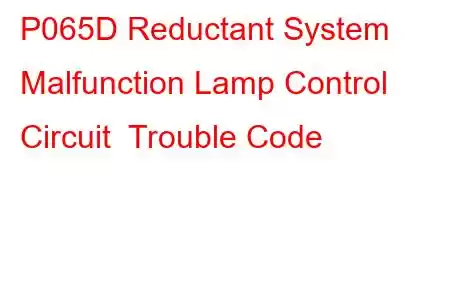P065D Reductant System Malfunction Lamp Control Circuit
OBD-II Trouble Code Technical Description
Reductant System Malfunction Lamp Control Circuit
What does that mean?
This is a generic diagnostic trouble code (DTC) and applies to many OBD-II vehicles (1996-newer). That may include but is not limited to vehicles from VW, Audi, Chevrolet, Chrysler, Ford, Dodge, GMC, Ram, Volkswagen, etc. Although generic, the exact repair steps may vary depending on year, make, model, and powertrain configuration.
A stored code P065D means that the powertrain control module (PCM), or one of the other related controllers, has detected a discrepancy in the reductant system malfunction lamp control circuit.
The reductant system malfunction lamp is an integral part of the instrument panel. It is designed to warn the driver of a fault in the reductant system. Typically, the PCM receives a signal from one of the reductant system sensors. Reductant system sensors allow the PCM to monitor the reductant system for malfunctions. When reductant system data is calculated by the PCM, and a problem is detected, the PCM emits a voltage signal to the reductant system malfunction warning lamp via the lamp control circuit. When the reductant system malfunction control lamp circuit is activated, the reductant system malfunction lamp should be illuminated.
When the key is placed in the on position (with the engine off) a self test is initiated for all instrument panel warning lamps. If a problem is detected in monitoring the reductant system malfunction lamp control circuit, a code P065D will be stored and a malfunction indicator lamp (MIL) may be illuminated.
A reductant DEF tank:
What is the severity of this DTC?
A P065D should be categorized as severe because it could result in an inoperative reductant system, catalytic converter damage, and/or drivability issues.
What are some of the symptoms of the code?
Symptoms of a P065D trouble code may include:
Inoperative reductant system Reductant system malfunction lamp is inoperative Reductant system malfunction lamp remains illuminated Engine drivability issues Catalytic converter codesWhat are some of the common causes of the code?
Causes for this code may include:
Defective reductant system malfunction lamp bulb Open or shorted circuit between the PCM and the instrument panel or other controllers PCM programming error Faulty controller or PCMWhat are some P065D troubleshooting steps?
If other reductant system codes are stored, these should be diagnosed and repaired before attempting to diagnose a P065D.
Consult your vehicle information source for technical service bulletins (TSB) that replicate the code stored, vehicle (year, make, model, and engine), and symptoms exhibited. If you find the appropriate TSB, it may yield helpful diagnostic information.
A diagnostic scanner and a digital volt/ohmmeter will be necessary to accurately diagnose a code P065D. A reliable source of vehicle information will also be required.
Begin by connecting the scanner to the vehicle diagnostic port and retrieving all stored codes and freeze frame data. You will want to write this information down, just in case the code proves to be an intermittent one.
After recording all pertinent information, clear the codes and test drive the vehicle (if possible) until the code is reset or the PCM enters readiness mode.
If the PCM enters readiness mode, the code is intermittent and will be even more difficult to diagnose. The condition, which caused the P065D to be stored, may need to worsen before an accurate diagnosis can be reached. On the other hand, if the code fails to reset and there are no drivability symptoms exhibited, the vehicle can be operated normally.
If the P065D is immediately reset, proceed with a visual inspection of system related wir
Read: 38


